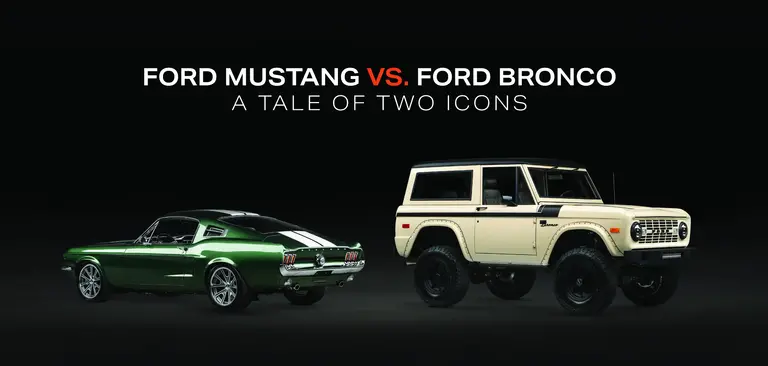These iconic vehicles, born in the 1960s, not only redefined their respective segments but also captured the imagination of a generation. As we delve into the legacy of these two legends, we uncover a story of innovation, rivalry, and enduring appeal.
The Dawn of the Mustang: America’s Original Pony Car
The Ford Mustang galloped onto the scene in April 1964, igniting the pony car craze that swept the nation. Conceived by visionary Lee Iacocca, the Mustang was a masterstroke of marketing and design. It offered the perfect blend of sporty performance, affordable pricing, and customizable options, appealing to a wide demographic from young professionals to racing enthusiasts.
 The Ford Mustang is officially unveiled by Henry Ford II at the World’s Fair in Flushing Meadows, New York, on April 17, 1964. | Credit: History.com
The Ford Mustang is officially unveiled by Henry Ford II at the World’s Fair in Flushing Meadows, New York, on April 17, 1964. | Credit: History.comThe Mustang’s debut was nothing short of sensational. It shattered sales records, selling over 400,000 units in its first year. Its impact was so profound that it spawned a new class of vehicles—the pony car—and inspired competitors like the Chevrolet Camaro and Pontiac Firebird. The Mustang’s legacy is marked by its appearances in pop culture, most notably in films like “Bullitt” and “Gone in 60 Seconds,” cementing its status as an American icon.
The Rise of the Bronco: Pioneering the SUV Segment
Just a year after the Mustang’s debut, Ford introduced another groundbreaking vehicle—the Ford Bronco. Launched in 1966, the Bronco was Ford’s answer to the growing demand for off-road vehicles. It was designed to be versatile, equally adept at handling rugged terrain and city streets. The Bronco’s compact size, powerful engine options, and four-wheel-drive capability made it an instant hit among outdoor enthusiasts and adventure seekers.
The Bronco’s appeal lay in its simplicity and functionality. It offered a no-frills, go-anywhere attitude that resonated with a wide audience. Over the years, the Bronco evolved, adding more comfort and convenience features while retaining its rugged charm. The Bronco’s legacy is defined by its role in popularizing the SUV segment and its cult following among off-road aficionados.
Mustang vs. Bronco: A Friendly Rivalry
While the Mustang and Bronco catered to different market segments, they shared a friendly rivalry within the Ford lineup. Both vehicles were symbols of freedom and adventure, albeit in different forms. The Mustang was the quintessential American sports car, embodying speed and style, while the Bronco was the rugged, go-anywhere companion for outdoor escapades.
Over the decades, both the Mustang and Bronco have undergone numerous transformations, adapting to changing consumer tastes and technological advancements. The Mustang has evolved from its original pony car roots to become a sophisticated sports coupe, while the Bronco has been reborn for the 21st century, blending modern amenities with its iconic off-road heritage.
Shaping the Ford Motor Company: The Impact of the Mustang and Bronco
The Ford Mustang and Ford Bronco are not just iconic vehicles; they are pillars that have helped shape the Ford Motor Company’s identity and legacy. Their introduction in the 1960s marked a pivotal moment in Ford’s history, setting the stage for innovation, growth, and a strong connection with American culture.
 Lee Iacocca, Ford Vice President, at the World’s Fair in Flushing Meadows, New York, on April 17, 1964.
Lee Iacocca, Ford Vice President, at the World’s Fair in Flushing Meadows, New York, on April 17, 1964.The Mustang: A Symbol of Innovation and Growth
The Ford Mustang’s launch in 1964 was a watershed moment for Ford. It symbolized a new era of innovation and creativity within the company. The Mustang’s unprecedented success challenged Ford to think outside the box, pushing the boundaries of automotive design and marketing. It demonstrated Ford’s ability to tap into the desires of the American public, creating a vehicle that was not just a mode of transportation but a lifestyle statement.
The Mustang’s impact on Ford’s growth was profound. Its popularity boosted Ford’s sales and market share, providing the financial resources to invest in further research and development. The Mustang’s success also spurred competition within the industry, driving advancements in performance, safety, and technology. As a result, Ford established itself as a leader in automotive innovation, a reputation that continues to this day.
The Bronco: Pioneering a New Segment
The introduction of the Ford Bronco in 1966 further solidified Ford’s position as a trailblazer in the automotive industry. The Bronco was one of the first vehicles to cater to the emerging market for sport utility vehicles (SUVs). Its versatility and off-road capabilities opened up new possibilities for vehicle use, appealing to a wide range of consumers, from outdoor enthusiasts to families.
The Bronco’s success in pioneering the SUV segment had a lasting impact on Ford and the automotive industry as a whole. It demonstrated the potential for vehicles that could offer both practicality and adventure, leading to the development of an entirely new category of automobiles. The SUV segment has since become one of the most popular and competitive in the industry, with Ford continuing to be a key player.
Conclusion: Legacy and Leadership
The Ford Mustang and Ford Bronco have played a crucial role in shaping the Ford Motor Company’s legacy and leadership in the automotive industry. They embody Ford’s spirit of innovation, adaptability, and connection with American culture. Through these vehicles, Ford has demonstrated its ability to anticipate consumer trends, lead market segments, and create products that resonate with generations of drivers.
As Ford continues to evolve in the face of new challenges and opportunities, the Mustang and Bronco remain symbols of the company’s enduring commitment to excellence and its ability to drive the future of mobility. They are not just vehicles; they are milestones in Ford’s journey, representing the company’s past, present, and future.



